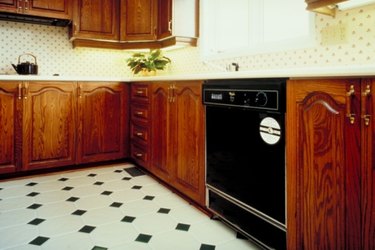Linoleum, durable and easy to care for, comes as tiles or a one-piece flooring option for use in any room of the house. Installers lay linoleum over the substrate and bond it with adhesive around the edges or spread adhesive over the entire subfloor. Large rooms require fitting pieces together and forming a seam when laying one-piece sheet flooring. Typically, professional installers fuse the seams with a heat bond, which is not a do-it-yourself project. Heat bonding requires specialized tools and experience. Do-it-yourselfers use adhesive to hold the seam in place. Over time and exposure to water, seams lift and curl, requiring repairs.

Video of the Day
Things You'll Need
Rag Or Sponge
Wax Paper
Paintbrush
Weights
Metal Putty Knife
Seam Sealer Kit
Broom Or Vacuum
Flooring Adhesive
Degreasing Detergent
Hand-Held Hair Dryer
Rolling Pin Or Floor Roller
Step 1
Sweep or vacuum the seam and surrounding area of the floor to remove dirt and dust. Clean the floor with a degreasing detergent to remove grease and oils that interrupt the adhesive bond.
Video of the Day
Step 2
Wave a hand-held hair dryer over the lifting or curling seam to heat the linoleum and make it more flexible. Keep the hair dryer in motion back-and-forth over the seam to prevent burning, bubbling or discoloring the linoleum.
Step 3
Lift the linoleum carefully by hand. Do not use excessive force when lifting the linoleum edges as you may tear the linoleum.
Step 4
Scrape out old adhesive with a metal putty knife.
Step 5
Apply a coat of linoleum flooring adhesive on the exposed subfloor with a putty knife or old paintbrush.
Step 6
Press the lifted or curled edges into the adhesive. Heat the linoleum edges with the hair dryer until the linoleum is flexible enough to uncurl and lay flat.
Step 7
Wipe away excess adhesive with a damp rag or sponge.
Step 8
Roll a rolling pin or floor roller over the seams to press them firmly in place.
Step 9
Lay a sheet of wax paper over the repair and place a weight on top of the wax paper. Wax paper prevents oozing flooring adhesive from bonding with the weight on the seams. Let the weight remain on the repair for 24 to 48 hours.
Step 10
Apply seam sealer from a commercially available seam-sealing kit to the edges of the seam with a seam sealer applicator. Check the flooring manufacturer's recommendations before using a seam-sealing kit. Seam sealers chemically melt the edges of the seams and fuse them together.
Tip
Consider having the seams professionally heat bonded if lifting or curling occurs again. Install base moldings over lifting linoleum around edges to prevent lifting and curling. Install a floor transition strip or saddle if lifting is a problem between rooms. Repair water leaks to prevent linoleum seams from lifting. Avoid using excessive amounts of water when cleaning a linoleum floor to prevent lifting and curling. Wear eye protection and work gloves when repairing linoleum edges.
Warning
Work in a well-ventilated room when using flooring adhesive. Avoid using a heat gun to warm linoleum during repair; the heat is too intense and may ruin the linoleum.